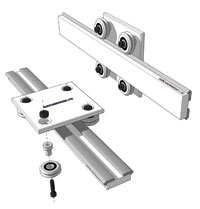
Posted to News on 18th Oct 2017, 00:00
Using Vee bearings and T-rails
Gerry Smith of Euro-Bearings offers hints and advice on installing linear systems.

Vee bearings and T-rails offer the user a simple way of constructing smooth running linear systems with a high load capacity and, in the case of the stainless steel version, corrosion resistance too. So let’s look at how we might build these components into a linear system.
The first thing to do is to decide the width of the track and then choose what material the T-rail will be attached to, the support. Importantly, the precision of the system is dictated by how accurately the support material is manufactured.
Drilling the T-rail is easy. The flats are not hardened, only the tip of the vee, so normal drilling techniques can be used. Our preference is to clamp the T-rail to the support material and to drill pilot holes through the T-rail into the support. This means the centres will match. Double check that the T-rail edges are still parallel, then drill through holes in the T-rails and drill and tap the support.
Finally bolt the T-rail onto the support. We tend to use dome head machine screws; make sure the screw heads do not interfere with the carriage or rail edges. Also make sure that the rail edges are parallel.
Let’s turn now to the carriage and bearings. First step is to select the material for the carriage – steel or aluminium. The hole centre positions for the bearings (dimension “A” on the drawing) can be calculated as:
A = Width of support + 2xTE + 2xA1
where TE is the offset of tip of the Vee rail from the support material, and A1 is the dimension from centre of bearing to bottom of Vee.
Drill the holes through the carriage plate. Insert the concentric bushes into two bearings and insert the eccentric bushes into two bearings. Firmly secure the concentric bushed bearings to one side of the carriage plate and tighten. Loosely assemble the eccentric bushed bearings to the carriage plate and slide the carriage onto the T-rails. Now adjust the eccentric bushed bearings by feel (or feeler gauge) to achieve the pre-load required. Slide the carriage back & forth to ensure there are no pinch points.
It is recommended to use hex cap head bolts and nyloc nuts through each bearing bush. Importantly, make sure the outer ring of the bearing is turning on the inner ring of the bearing and not on the bush. The bearing should be an interference fit onto the bush.
Units 29-31 Orchard House, Lodge Farm Business Centre
Wolverton Road, Castlethorpe
MK19 7ES
UNITED KINGDOM
+44 (0)1908 511733








